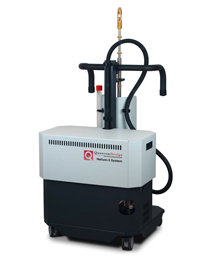Measurements below 2 K
- Helium-3 refrigerator
The He-3-refrigerator uses the rare helium-3 isotope. Helium-3 has several advantages over helium-4 when it comes to reaching temperatures below 2 K. It has a lower boiling point and higher vapor pressure. The heat capacity of the liquid is less prone to vary and does not transit into a superfluid state in the designated temperature range.
The helium-3 refrigerator uses the evaporation heat to provide sub-1 K temperatures. Our PPMS’s He3-system has a base temperature of 400 mK. The refrigerator can be used in combination with electric measurements or with the heat capacity option. A different type of He3-refrigerator is available for magnetic measurements in the MPMS3 SQUID magnetometer. The comparatively high purchase price is compensated by the closed-cycle design which ensures that one helium-3 filling can be used for a very long time.
- Dilution refrigerator (DR)
Our dilution refrigerator option for the PPMS system reaches low temperatures by using the heat that occurs when mixing the two helium isotopes He3 and He4.
It can be used for heat capacity and electric measurements. Electric measurements are limited to lower currents as the cooling power is lower than that of the He3-refrigerator. Our Quantum Design DR-system allows magnetic measurements in the PPMS (AC-DR option, AC-susceptibility). It has a small footprint and takes much less of the He3 and He4 gas mixture than larger DR-systems, making it a comparatively low-priced alternative. - Adiabatic demagnetization refrigerator (ADR)
Our PPMS ADR-insert provides temperatures down to 100 mK. The ADR principle is based on the disorder entropy of (electronic) magnetic moments in paramagnetic salts. The salt is cooled down in a magnetic field to the system’s base temperature. Then the magnetic field is removed which starts the cooling process. The magnetic spins of the salt now orient randomly. The entropy change S can be described by S = R ln (2J+1) with J being the angular momentum. The ADR process has a large entropy change in the order of joules per mole.
Adiabatic demagnetization refrigeration is very easy to use and the quickest way to reach 100 mK. However, it is limited to measurements without magnetic fields and it does not allow temperature control. Data is taken while the sample warms back up to 1.9 K.
Did you know?
- Under regular pressure, 30 elements of the periodic table show superconductivity. Only 10 elements have a transition temperature above 1.9 K. Niobium has the highest with a TC of 9.2 K.
- Helium-3 gas is a by-product from the decay of the radioactive element tritium. It is frequently used in instruments for neutron detection.
- The Dutch scientist Heike Kamerlingh Onnes is considered the “Father of low-temperature physics”. He was the first person to liquefy helium in 1908 and he discovered superconductivity in 1911 (Mercury with TC = 4.2 K).
- W.F. Giauque and D.P. MacDougall were the first to practically realize an ADR in Berkley in 1933. It was the first important low-temperature experiment since the end of the 19th century which had been successful outside the University of Leiden.

